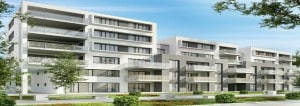New balcony and terrace design standard | BS 8579

A new British Standard provides guidance on balcony and terrace design at a time when such features are becoming more and more common. This blog post explains why the standard was written, who by and what it contains.
There has been a consensus for some time that the UK construction sector would benefit from authoritative guidance on the design of balconies and terraces. On the one hand, these features are becoming more common because of the increasing number of medium- and high-rise residential developments being built with outdoor amenity space. On the other hand, UK construction industry opinion seems frequently to be divided as to how best to design balconies. This British Standard was therefore developed with the aim of setting a new benchmark for quality and functionality in the design of balconies and terraces.
The standard was drafted by a panel of experts which included architects, balcony manufacturers and structural engineers as well as fire safety, drainage, acoustic and accessibility experts. The result is BS 8579:2020 Guide to the design of balconies and terraces, which was published at the end of August.
General overview
BS 8579 gives guidance on the design of balconies and terraces and their component parts. The standard applies to terraces and projecting, inset, open and enclosed balconies. It also defines Juliet guarding, but covers their guarding elements only. Whilst the standard is not intended to cover internal balconies, such as within a building atrium, relevant guidance in the standard can be used in the absence of guidance specific to such balconies.
As a general principle, balconies and terraces should be designed to provide amenity to building users and should be an appropriate size for their intended use. They can either be open, wholly or partly covered, or enclosed. Irrespective of type, the design should consider wind effects, service life, inclusive design, structural and mechanical stability and integrity, safety, fire performance, thermal considerations, proximity to ventilation outlets, weathering and drainage, security and acoustic performance. Each of these aspects is addressed throughout the rest of the standard and some are highlighted below.
Wind effects
Wind can have a significant effect on a balcony or terrace, its occupants and objects. This is particularly the case if the balcony is at a higher elevation than surrounding buildings, exposed to the direction of the prevailing wind, situated on the corner of a building or located close to other buildings. Recommendations are given to mitigate adverse weather effects for both occupant safety and comfort.
Inclusive design
Balconies provide an essential amenity space for building occupants and should be designed to provide equal utility and enjoyment for all users. Considerations include door and threshold design as well as surfaces, sightlines and dimensions.
Safety
Several aspects affect the safety of people on balconies and those below. These include loading limits, guarding considerations (including dimensions), slip resistance and the potential for objects or other materials to fall from the balcony. The safety of people involved in the construction, cleaning, maintenance and dismantling of balconies should also be considered.
Fire performance
The existence of a balcony or terrace should not give rise to additional fire risk to a building or others nearby. It is therefore essential to consider balcony arrangement, details, materials and components to reduce fire risk to a minimum.
Weathering and hydraulic design
An understanding of how rainwater affects a balcony and its surrounds is essential for good design. This includes the effect of incident rain, drainage strategies and outlet design as well as the prevention of water ingress at thresholds and openings. Guidance for the assessment of the volume of rainwater is provided.
Summary
This comprehensive new standard provides valuable guidance for anyone with a professional interest in balcony and terrace design. A supporting webinar is available online.


